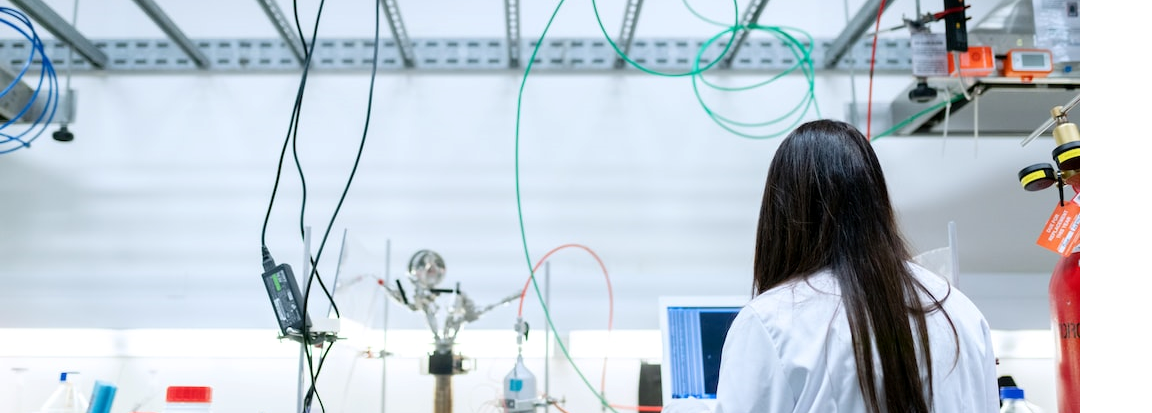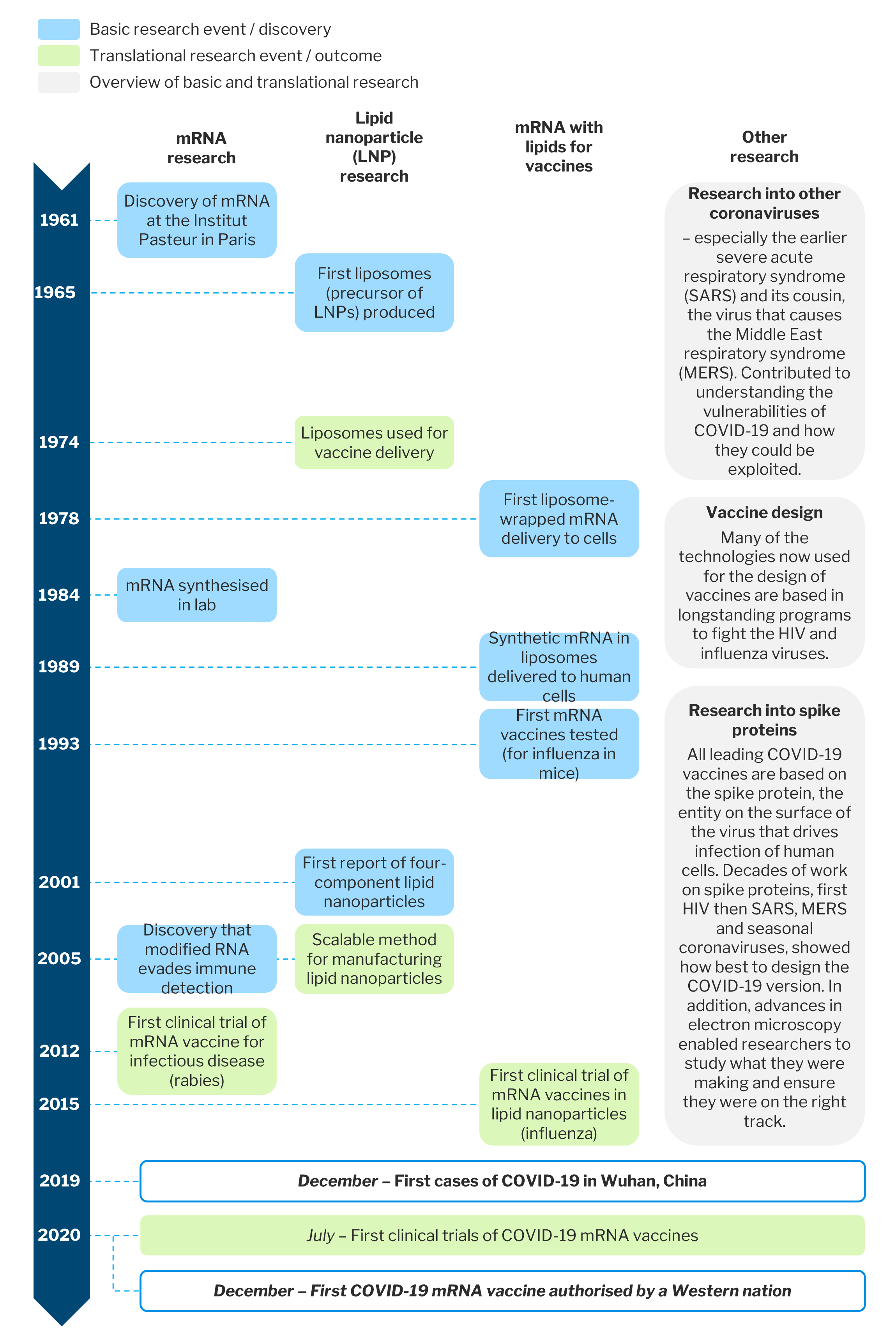Insights
Research – Balancing the portfolio


The case for renewed focus on high quality basic research
Key Takeaways
- In times of crisis we rely on high quality research to drive innovation and impact
- Research funding is increasingly focused on translation
- This has seen a medium term decline in funding for high quality basic research
- Basic research is the foundation of a knowledge economy
- Australia needs to support the foundations of our future, via a balanced portfolio of publicly funded research
History tells us – we lean on fundamental research in difficult times
In December 2020, the UK became the first western jurisdiction to license a COVID-19 vaccine – a year after the first cases of the novel coronavirus were reported in Wuhan, China. The development of vaccines usually takes several years, beginning with many years of research in laboratories to understand the biology of a disease, followed by several stages of clinical trials on human subjects. Adding to the time lag is the reluctance of pharmaceutical manufacturers to invest in large scale production until they know the vaccines will work.
In the case of COVID-19, governments, ethics approval boards, manufacturers and regulatory agencies across the globe all came together to accelerate processes, remove funding barriers, and de-risk production, while tens of thousands of citizens keenly volunteered to participate in clinical trials, eliminating the often-challenging process of recruiting trial participants.
But the main protagonists of the COVID-19 vaccine story were the scientists, rarely in the public spotlight, who worked tirelessly and with impressive speed on the laboratory and clinical experiments necessary to design, test and develop the vaccine in record time. (Indeed, Time magazine named four of those scientists their “Heroes of the Year”, dubbing them “the miracle workers”1.)
The development of the pandemic-curbing COVID-19 vaccines provided a tangible and compelling demonstration of the fundamental importance of research to underpin the products and inventions that improve and save lives.
Research investment is Growing – but not from direct investment by Government and Business
Research in Australia is undertaken in a range of settings – private businesses/industry, universities, government institutions and not-for-profit organisations (predominantly medical research institutes).
Australia’s Gross Expenditure on Research & Development (GERD) grew by 12 per cent between 2011 and 2020, driven primarily by the higher education sector, where expenditure increased by nearly 50 per cent, from $8.9b to $12.7b (see Figure 1). Over the same period of time, direct investment by government and business remained relatively flat. The vast majority of research expenditure in higher education is in the STEM and medical disciplines.
Figure 1: Australia’s GERD by Sector, 2011-2020
($b, ABS, August 2023)2

Research funding is increasingly focused on translation
Scientific research can broadly be divided into two categories – basic and translational. Basic research is focused on developing an understanding of the facts and fundamental natural phenomena that underlie health, disease, the environment etc. With basic research, there is no specific use or practical application of the research outcomes in mind; increasing knowledge of the subject is the goal.
‘Translational’ research (sometimes called ‘bench-to-bedside’) is the process of taking scientific discoveries and using them to develop solutions to specific problems, such as new drugs to treat a disease or changes in clinical guidelines and public policy. The objective of translational research is to have real-world impact, including financial or economic, which can be tangibly measured and demonstrated.
Figure 2: Characteristics of Basic and Translational Research

The shift in funding from basic to translational
In Australia, between 30-40% of research is publicly funded through a variety of government grant programs3. Over time, public funding has increasingly shifted from basic to translational research, with numerous federal and state government funding initiatives seeking to accelerate transformative research and commercialisation which advances economic innovation and social outcomes. Examples of these programs include the federally-funded Medical Research Future Fund (MRFF), the Modern Manufacturing Initiative (MMI), Cooperative Research Centres (CRC) Grants, the University Research Commercialisation Action Plan, NSW-based Future Economy Fund, Translation Research Grants Scheme and Medical Devices fund and, in Victoria, the Victorian Medical Research Acceleration Fund and Breakthrough Victoria.
This shift to translational research in the scientific and medical research disciplines has occurred in response to widely held views, such as those reported in the 2012 McKeon Review, that Australia was failing to extract the full social and economic benefits of its world-class research due to “a lack of funding for early clinical projects and an underdeveloped culture for the commercialisation of innovation, with limited knowledge and skills among the research community”4.
Australian translational research success stories
Twenty years of basic research at the Walter and Eliza Hall Institute (WEHI) paved the way for a revolutionary treatment of leukaemia
After two decades of research to understand the nature and functioning of the cancer-driving protein BCL-2, WEHI scientists collaborated with pharmaceutical manufacturers Genentech and AbbVie to develop the drug venetoclax. Since being approved for use in 2016, the drug has seen patients with certain advanced forms of leukaemia achieve complete remission.
The world-changing technology of wifi emerged from pioneering basic research in radio astronomy at the CSIRO
In the 1990s, radio astronomers at the CSIRO applied a mathematical solution that they had been using to unscramble radio waves from space to solve a major problem in the newly emerging field of wireless internet technology – the way in which radio waves get bounced around in congested interior environments, distorting the signals. The IP they developed was used by the largest tech companies in the world to invent wi-fi, found today in over 5 billion devices around the world.
The work of a Nobel-prize winning German virologist going back to the 1970s laid the foundation for a vaccine against cervical cancer
Drawing on Dr Harald Zurhausen’s ground-breaking discovery that the human papillomavirus (HPV) could cause cervical cancer, scientists at The University of Queensland spent over ten years working to develop a vaccine. After hundreds of experiments and various setbacks, the researchers were finally able to licence the technology through CSL to US pharmaceutical company Merck & Co. They used it to develop a vaccine now sold as Gardasil®, which is today used in 121 countries and has been administered more than 125 million times.
Certainly, the increase in funding for translational research has been beneficial for universities, as it has opened the door to great collaboration with industry and more diverse revenue streams. However, as a result, in 2020 less than 40% of all research expenditure in higher education (HERD) was directed to basic research, compared with almost 60% in the mid-1990s (see Figure 3). Were this trend to continue, by the mid-2060s, there would be no expenditure at all on basic research.
Figure 3: HERD by research type, 1996-2020
(%, Commonwealth Department of Education, December 2022)5

DEFINITIONS6
Applied research is original work undertaken primarily to acquire new knowledge with a specific application in view. It is undertaken either to determine possible uses for the findings of basic research or to determine new ways of achieving some specific and predetermined objectives.
Experimental development is systematic work, using existing knowledge gained from research or practical experience, that is directed to producing new materials, products or devices, to installing new processes, systems and services, or to improving substantially those already produced or installed.
Pure basic research is experimental and theoretical work undertaken to acquire new knowledge without looking for long term benefits other than the advancement of knowledge.
Strategic basic research is experimental and theoretical work undertaken to acquire new knowledge directed into specified broad areas in the expectation of useful discoveries. It provides the broad base of knowledge necessary for the solution of recognised practical problems.
Translation cannot happen without a bedrock of basic research
Translational research gives us tangible products and practical solutions, like the COVID-19 vaccines mentioned at the beginning of this article. This kind of research is undeniably important and worthy of support. So it may be tempting to ask why taxpayer dollars should be invested in basic research which is not directly aiming to solve a ‘real-world’ problem, like preventing COVID-19 infection?
At SPP, we think that it is short-sighted to privilege translational research at the expense of basic research, quite simply because the former cannot exist without the latter. A closer look at the development of the COVID-19 vaccine shows that it would not have been possible without underlying basic research undertaken over decades by thousands of scientists around the world.
Released just 12 months after the first reported cases of the virus, the Pfizer-BioNTech and Moderna mRNA vaccines against COVID-19 were the fastest vaccines to ever be developed. But it was only thanks to a long chain of scientific advances through basic research over many decades that this was possible (see Figure 4).
Messenger RNA, or mRNA, is a type of molecule in the body that contains the instructions that directs cells to make a specific protein. Discovered in the early 1960s, it was not initially being considered as a medical product; instead, scientists hoped to use it as a medium to investigate basic molecular processes.
In the mid-1980s, researchers were able to synthesise mRNA in a lab, which theoretically opened the path to medical applications. However, it was a very unstable molecule that degraded in the body before it could have the desired effect. The solution to this problem came from advances in nanotechnology in the early 2000s: the development of fatty droplets (lipid nanoparticles) that wrapped the mRNA like a bubble, allowing entry into the cells.
Early experiments had also shown that the entry of mRNA into cells triggered a severe immune response, and it was only a breakthrough discovery in 2005 that made the use of mRNA in vaccines finally possible. (In 2021, the scientists responsible for this discovery received a Golden Goose Award, which recognises groups of researchers whose seemingly obscure, government-funded research led to major breakthroughs in biomedical research, medical treatments, and computing and communications technologies).
Figure 4 – Example Research and Translation Timeline

All of this basic research, together with parallel streams of discovery research in other areas of molecular biology, genetic sequencing, immunology and vaccinology could be rapidly mobilised in 2020 to develop the vaccines that helped to curtail the COVID-19 pandemic.
Basic research is the foundation of a knowledge economy
Basic research is important, because it provides the capability base for individual researchers and Australia’s knowledge and innovation system, enabling the translational research that gives us things like vaccines. A strong basic research base cultivates a number of key capabilities including:
- The ability to pose meaningful research questions;
- The ability to design robust methodologies and experiments to answer those questions; and
- An ever-increasing understanding of health, disease, and the world around us, which provides the platform to solve current and future problems.
As for government funding of research: we can think of this as being like an investment strategy. We know that characteristics of a strong investment portfolio include a diverse mix of asset types and, importantly, a balance of short and long-term prospects – those that capitalise on current market conditions and deliver quick profits versus those that only yield a return after many years, potentially as a financial legacy for the next generation.
The national funding of research is no different. We need to support high quality translational research that helps to accelerate solutions to urgent, present-day problems. But we must also continue to fund a pipeline of high quality basic research as a long-term investment; to ensure which ensures that we develop the foundational understanding that will enable us to solve many problems decades into the future – maybe even ones that don’t yet exist! Of course, there will always be a risk that those real-world impacts don’t materialise. But as with financial investments, this can be tolerated as part of a balanced portfolio.
The importance of Research Quality
We have been arguing here that both basic and translational research are important and should be appropriately funded. Underpinning our argument is a strong view on the importance of research quality and the need for systems and processes to ensure that only high quality research is executed and supported by public funds.
The Australian government’s lead agency for funding health and medical research, the National Health and Medical Research Council (NHMRC), has published a Research Quality Strategy7, in which it defines the key characteristics of “quality research” to be:
Rigour – underpinned by robust scientific methods and avoidance or acknowledgment of biases;
Transparency – research findings, supporting data and enabling methodologies are shared and communicated openly, responsibly and accurately;
Reproducibility – being able to obtain consistent results using the same data, methods, computational steps and conditions of analysis8.
Indeed, these principles are widely considered to be the underpinnings of reliable scientific research. However, a 2019 survey by NHMRC of academics and research students in Australian tertiary institutions revealed a wide diversity of views among participants around the definition of quality research. More concerning, though, were the reports from survey participants about aspects of their institutional research culture and broader factors in the academic environment that present barriers to excellence in research quality.
These findings reflect concerns about research quality that have been reported internationally across all scientific disciplines. Of particular concern are reports about avoidable waste in the production and reporting of research and the lack of reproducibility of published studies.
An assurance of quality in research is important because it promotes community confidence in the findings of research. This trust, in turn, inspires others to use and build on the research and attracts collaboration and investment. Research quality, in other words, maximises the opportunity for the research to have real-world impact and deliver a return on public investment.
Our call to action – maintaining and strengthening our foundations for the future
At SPP, we believe that Australia needs a strong and well-resourced basic research system to advance scientific progress and provide the foundation for ground-breaking solutions to our most pressing social and environmental problems. We need a balanced portfolio of publicly funded research, which views translational and basic research as interdependent ends of a spectrum, both worthy of investment.
Complementing the direct funding of basic research, we also need a robust training system for academic at all levels – from PhD candidates through to early and mid-career researchers – that supports contemporary research capabilities including:
- The ability to define a problem that a broad range of stakeholders would want to see solved;
- An understanding of intellectual property and how to define and protect it;
- The ability to envisage and assess the impact of research – increasingly a requirement of research funding; and
- The ability to communicate and work with people from other sectors, notably industry and community groups.
Finally, we need a consistent and widely understood framework for research quality, and – a more comprehensive and systemic challenge – the removal of institutional, financial and other barriers to achieving it.
If we can get all of this right, we can maximise the chance that our investment in research will yield great benefits to our society and economy – an increase in innovation and problem solving, more jobs for highly-skilled workers and the ability to develop solutions to mitigate future shocks and challenges, such as new pandemics and the ever-present threat of climate change.
About SPP
Strategic Project Partners is Australia’s leading higher education and research consulting firm. We have over 18 years’ experience in higher education consulting and have helped Australia’s top universities achieve their strategic goals. The research sector has been an intentional focus for SPP over many years and our team has developed deep expertise in this area.
SPP is a preferred partner for research strategy, bid development and commercialisation because we understand research, can make sense of the complexity and translate findings. Our team includes former medical researchers and academics, as well as professionals who have worked alongside academics to raise funding for and commercialise research.
SPP has an outstanding track record assisting higher education clients to secure major research funding. We work with academics, research teams and institutions to:
- Build a compelling bid narrative
- Articulate winning value propositions
- Identify the path to impact
- Quantify and communicate impact
We are proud of the role we play in helping researchers in universities and other institutions deliver impact across social, cultural and economic domains. Please reach out to us to discuss how we can help you, your team or your institution achieve their strategic research goals and secure their funding needs.
- Park, A. & Ducharme, J. (2021) “Time 2021 Heroes of the Year: The Miracle Workers”, https://time.com/heroes-of-the-year-2021-vaccine-scientists/. Accessed 15 August 2023. ↩︎
- Australian Bureau of Statistics (2023), “Research and Experimental Development, Businesses, Australia”, https://www.abs.gov.au/statistics/industry/technology-and-innovation/research-and-experimental-development-businesses-australia/latest-release. Accessed 7 August 2023. ↩︎
- Australian Bureau of Statistics (2023), “Research and Experimental Development, Businesses, Australia”, https://www.abs.gov.au/statistics/industry/technology-and-innovation/research-and-experimental-development-businesses-australia/latest-release. Accessed 7 August 2023. ↩︎
- Australian Bureau of Statistics (2022), “Research and Experimental Development, Higher Education Organisations, Australia”, https://www.abs.gov.au/statistics/industry/technology-and-innovation/research-and-experimental-development-higher-education-organisations-australia/latest-release. Accessed 29 August 2023. ↩︎
- Australian Bureau of Statistics (2022), “Higher education expenditure on R&D by higher education provider”, https://www.education.gov.au/research-block-grants/resources/higher-education-expenditure-rd-higher-education-provider. Accessed 31 July 2023. ↩︎
- Australian Bureau of Statistics (1998), “Australian Standard Research Classification (ASRC), https://www.abs.gov.au/ausstats/abs@.nsf/66f306f503e529a5ca25697e0017661f/22E4C184CA111129CA25697E0018FD78?opendocument. Accessed 13 August 2023. ↩︎
- NHMRC (2019), NHMRC’s Research Quality Strategy, https://www.nhmrc.gov.au/about-us/publications/nhmrcs-research-quality-strategy. Accessed 14 August 2023. ↩︎
- National Academies (2019), “New Report Examines Reproducibility and Replicability in Science, Recommends Ways to Improve Transparency and Rigor in Research”, https://www.nationalacademies.org/news/2019/05/new-report-examines-reproducibility-and-replicability-in-science-recommends-ways-to-improve-transparency-and-rigor-in-research. Accessed 14 August 2023. ↩︎
Key Contacts
Ben Apted / Senior Partner
Ben Apted is the Senior Partner of SPP. Ben leads SPP's Education, Research and Digital Practices. Ben is a thought leader and contributor nationally and internationally on higher education strategy, engagement and operations. He has led transformation of government service...
Connect on email
Connect on LinkedIn
Dr Kim Poth / Principal
Kim Poth is a Principal at SPP and an experienced management consultant focused on the higher education, research and government sectors. Kim advises clients on strategic planning; policy design, implementation and review; performance improvement; benefits realisation and transformation. She has led significant strategy and transformation projects...
Connect on email
Connect on LinkedIn


